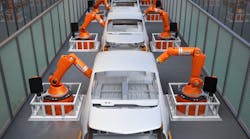Will Healy III is the Marketing Management Director at Balluff Inc. in Florence, Ky., and is enthusiastic about smart manufacturing, STEM, and vocations education. Will graduated from Purdue University with a degree in mechanical engineering and has been sharing his passion for automation for more than 10 years in a variety of industries. Will Healy III will be presenting “Why Manufacturers Must Embrace Industry 4.0” at CMTS on Tuesday, September 26 at 10:30 a.m.
Industry 4.0 is a term that has pervaded manufacturing circles for the past five years. For me, it is synonymous with analytics, the collection of data and, most importantly, the ability to make decisions based on the data collected.
Insights reduce downtime on the shop floor
A recent article in Fortune magazine reported that General Motors collects data from 800 robots—as well as numerous conveyor-belt machines and temperature systems—involved in the assembly of cars and trucks. GM then runs algorithms that turn this data into valuable insights that allow management to avoid mishaps, improve quality control, and predict equipment failures. The latter issue has a significant impact on downtime, as connected equipment can report when a component fails, or is about to fail. This allows GM to schedule maintenance, order supplies, and reduce operating costs.
Every company that I work with is motivated to reduce, or eliminate, their manufacturing downtime. Some of my clients have attached a price tag to manufacturing interruptions: $400-500 per minute - that’s $24,000-30,000 per hour, in case you’re wondering. In response to this sizeable cost, nearly three-quarters (73 percent) of manufacturers surveyed have a budget dedicated to the collection and analysis of manufacturing-related data.1
Data-driven quality control
Many manufacturing companies rely on an ecosystem of partners that provide parts and components for their products. Imagine a large automobile manufacturer discovers a quality defect in a component that is delivered by one of its suppliers. When the defective component gets introduced to the manufacturing process, production is stopped.
In response, the supplier adds a connected sensor to their assembly equipment. This sensor confirms the quality of the component, and then stores that data. Now, the automobile manufacturer can be confident that all components are complete; a fact that can be validated with hard data.
New technology improves existing equipment
One of the challenges associated with collecting data from existing equipment is that not all machines, devices, and sensors are “connected.” Connected devices have been a trending topic with explosive growth in connecting more machines and devices using wired Ethernet.
However, connecting every piece of equipment in a factory—including small sensors, like the ones found in proximity switches and pressure-detection instruments—with Ethernet might not make sense from a financial perspective. The overhead required to run the cables, manage all the switches, interface with IT, and assign IP addresses on these devices would be prohibitive.
This is where innovations like IO-Link come in. IO-Link is an open protocol that is ideal for devices that produce small amounts of data. Instead of the cost and effort required to attach these devices with Ethernet, IO-Link leverages the existing wire that already links them. By attaching multiple (up to eight) sensors to a single master—which is then connected to a controller using Ethernet—data can be collected in a timely and cost-effective manner.
In addition, if one of these small devices ever fails, a technician can perform a “hot swap”—simply replacing the sensor with a new one. IO-Link configures and activates the new device automatically and instantly, minimizing downtime.
Big data implementation; it takes a village
In my experience, there are five key steps to implementing an Industry 4.0 strategy:
- Build a multi-disciplinary team.
- Ensure management support for the initiative.
- Provide the team with clear goals and objectives.
- Empower the team with the authority to make decisions.
- Equip the team with a dedicated (and appropriate) budget.
1. “Industrial Internet of Things,” Automation World, August 2015.

